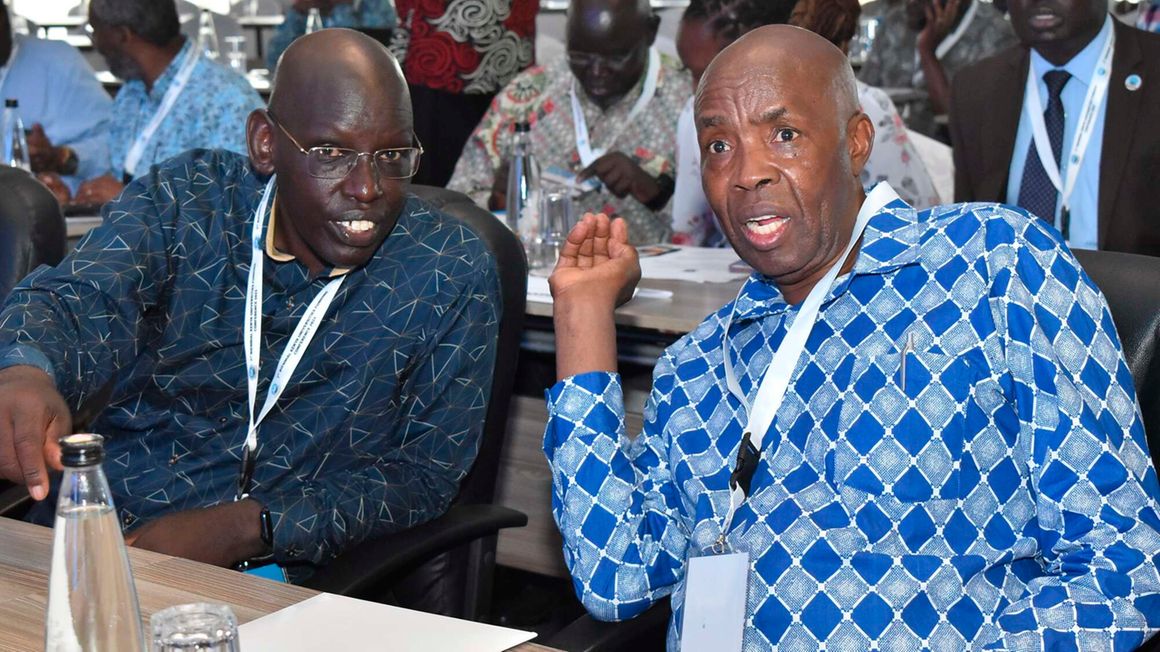
Education Cabinet Secretary Ezekiel Machogu and Education PS Belio Kipsang discuss during the 1st Biennal Kenya Universities Fund Conference 2023 at Flamingo By Pride Inn in Shanzu Mombasa County on February 23, 2023. PHOTO | WACHIRA MWANGI | NMG
The government has turned down Sh41.6 billion in funding requests from Public universities and the Higher Education Loans Board (Helb) amid a fee-hike proposal that will see tuition fees more than triple if implemented.
An analysis of official data shows that public universities and Helb, which have blamed their underperformance in recent times on underfunding, had demanded a total of Sh144.6 billion in the upcoming financial year starting July from the National Treasury but were allocated Sh103 billion.
This left the 39 public universities with a deficit of Sh41.6 billion, which will force the cash-strapped universities to tighten their belt by doing away with some expenses including scrapping some courses, which will in turn lead to staff layoffs.
Read: Time to review public varsity funding model
This deficit is wider than the current one for Financial Year 2022/23 of Sh27.9 billion, pointing to a trend where the government has not been able to keep up with the growing funding needs of public universities.
Public universities had a funding requirement of Sh71.9 billion in the current Financial Year ending June but were only allocated Sh44 billion, according to official data.
Kenyatta University had the largest deficit at Sh10 billion after its demand of Sh19.7 billion was slashed by more than half.
The National Treasury has only allocated it Sh9.65 billion, which is under half of what the university had demanded.
It is a decision that might not help solve the college’s current financial crisis which has seen Auditor General Nancy Gathungu declare it technically insolvent.
Jomo Kenyatta University of Agriculture and Technology (JKUAT) did not get Sh2.5 billion out of the Sh9 billion that it required.
The Technical University of Kenya had a deficit of Sh2.2 billion, Egerton University (Sh1.8 billion), Kaimosi University (Sh1.36 billion), and Karatina University (Sh1.35 billion).
The Technical University of Mombasa had a deficit of Sh1.3 billion, Maseno University (Sh1.1 billion) and Moi University (Sh1 billion).
Nearly all the colleges did not have their wishes met, except for Co-operative University and Garissa University.
Co-operative University surpassed their requirements by Sh20 million while Garissa University was allocated their spending needs of Sh701 million.
“The growing deficits only mean that the pending bills will continue to grow, thereby worsening the current problems. Unless the problem is addressed as a matter of urgency, our universities will face difficulties existing as going concerns,” said Education Cabinet secretary Ezekiel Machogu.
Mr Machogu was speaking during the opening of the first biennial Kenya Universities Funding Conference that was held on Thursday in Mombasa.
Mr Machogu acknowledged that public universities have challenges with a debt of Sh56 billion in the form of unremitted staff pensions and statutory deductions such as pay-as-you-earn (PAYE).
Helb, which supplements the 80 per cent that State-sponsored students receive, saw close to Sh9.8 billion of its request rejected with the exchequer only approving an allocation of Sh17.8 billion to the students’ loan body.
Helb, which has been looking for alternative ways of raising funds even as it aggressively goes after defaulters, had requested Sh27.6 billion from the exchequer.
State financing of public universities has been stagnant against a drop in enrollment of parallel students with all the secondary leavers scoring C+ and above being admitted under the government-sponsored programme.
This has not only increased the government’s liability but has also reduced a critical revenue stream for public universities leaving most of them in financial straits.
Public universities are some of the state corporations on the radar of the IMF under a 38-month programme aimed at helping Kenya to reduce debt vulnerabilities by reducing non-essential spending and increasing tax revenues.
Public universities have found themselves in deep financial straits blamed on falling student population, mismanagement and low State funding.
Read: New varsities funding formula out in July 2023
The Government, whose priority is on rebooting the economy that is yet to recover from the aftershock of the Covid-19 pandemic, drought and the Russia-Ukraine war, reckons that this funding gap can be plugged by students, especially the rich ones, paying for their own fees.
A Presidential task force on education has already recommended a hike in tuition fees from the current Sh16,000 per student to Sh52,000, a move that some analysts fear will deny a lot of students an opportunity to undertake their university education.
Last year, the University Funding Board (UFB), the State agency that guides allocations of student funds to universities said that it wanted students from wealthy families to pay the full or a larger share of the cost of degrees, starting with this year’s intake.
President Ruto has promised to convert Helb into a grant, a move that would make everything, from tuition fees to accommodation, free.
However, the government is grappling with many pressing needs, including high debt repayment as well as a drought that has pushed up the cost of living.
→ dakure@ke.nationmedia.com




No comments :
Post a Comment